Archived Storm Damage Blog Posts
Storm Damage in Glendale California
1/30/2023 (Permalink)
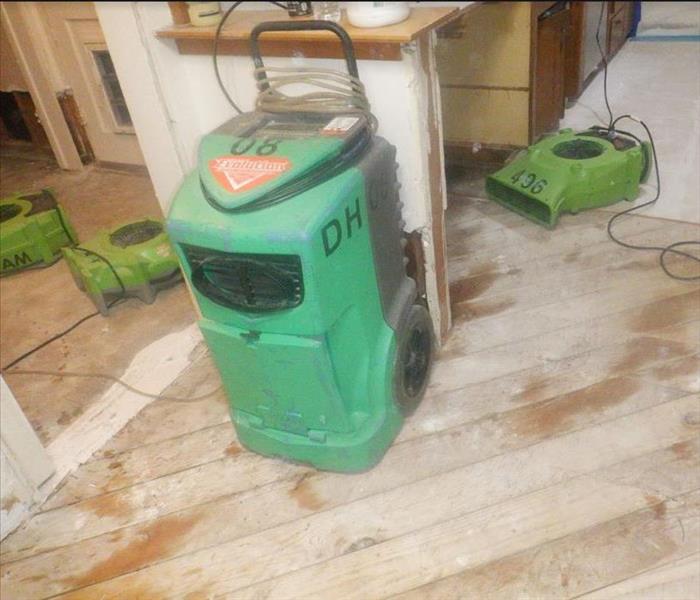 Our storm restorarton technicians are certified, experienced, and know exactly what they're doing.
Our storm restorarton technicians are certified, experienced, and know exactly what they're doing.
Preparing for Los Angeles rain
One of the greatest attractions in southern California is our weather. Especially in the Glendale area, Mother Nature plays a great part in the beauty of our community. Our late summers in the fall months often dictate how much rain we’ll get during the fall and winter. This year, Summer was cut short, with the first downpour in late October, flooding streets, homes, and other structures in our area. Before the next storm arrives, practice prevention from water damage by checking all these key areas of your property:
In addition, storm drains along the exterior of your structure need to be cleared of debris, leaves, branches, and other materials that can block ways for water to escape. Note that the best times to check these areas are the months right before expected rain arrives!
When a water damage emergency happens
Imagine this: After a long busy work week, it’s Friday, and all you want to do is get home, get comfy, and put your feet up for the rest of the night. Problem is, the minute you take your shoes off at the front door, you step into WET CARPET! Your socks are soaked, it’s cold, and your weekend has just begun, but not the way you hoped. What do you do?
Simple! Call SERVPRO of Central Glendale for your next steps. Whether it is from a storm backup, or an overflowing faucet that a family member may have forgotten to turn off, water losses are unexpected, and an inconvenience. The first thing first is to identify the source that caused the loss, to prevent more loss to occur. Please note: There are safety precautions when looking for the source. Electricity and water are dangerous if (unfortunately) found together. Call 9-1-1 ASAP if this is the situation.
Call Glendale’s #1 Storm Damage Restoration Service
If you have questions or require services, call SERVPRO of Central Glendale at 818-246-2200.
Our highly trained, professional staff will:
- Determine the extent of the water damage.
- Provide steps and a plan for drying.
- Use highly technological equipment to correctly mitigate the water for extraction; and
- Restore your property, “Like it never even happened."
If you’re ready for southern California’s #1 water and storm damage professionals to take care of your property, look no further. Give us a call today and see how easy it is to work with us!
How to Avoid Water Damage and Mold During Heavy Rain
12/12/2022 (Permalink)
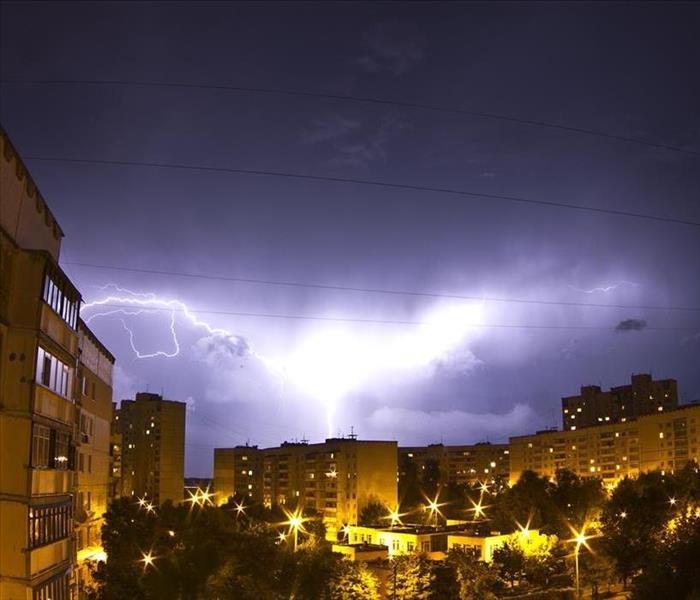 Rainwater can cause serious damage including mold and leaks.
Rainwater can cause serious damage including mold and leaks.
If there are heavy rains and your home has undiscovered leaks, you will likely have a mold problem soon.
Rainwater damage and mold go hand in hand. Mold may sound like a rare issue found in only the dingiest of homes, but mold lives everywhere. Even in the cleanest spaces, mold spores can be found floating around. When it comes to mold in your home, the key is to ensure mold levels stay in an acceptable range. It is impossible to eliminate mold entirely but if one area gets too damp, mold can fester at elevated levels without your knowledge. Mold becomes problematic in these concentrated, unseen situations.
The Good and Bad Things About Mold
Though it may sound surprising, mold can be a good thing in specific settings. In nature, mold breaks down organic materials to feed and nourish the soil. Mold makes some cheese taste great too. If you notice mold in your home, don’t freak out! Mold is natural and fixable.
Mold only becomes a problem when it grows excessively. As we said, all it takes for a mold infestation to grow is a damp, dark area. Often caused by heavy rains, humidity, or leaks, excessive mold can become hazardous to your home and family. The key is to remain diligent and take preventive measures before the rainy season approaches to fend off water damage and mold.
Water and mold damage restoration
If mold infests your home, it is important to understand the water and mold damage restoration process. The first thing that should be on the top of your list - hire an expert! Mold is not something to mess around with. To solve the problem efficiently and effectively, you will need a qualified restoration company to handle your water and mold damage restoration.
Water and mold damage restoration includes a wide spectrum of services and solutions. In some cases, you may be able to clean mold problem areas to resolve the infestation. Sometimes, mold damage requires more intensive solutions. Additionally, mold restoration may require testing for asbestos and lead. It’s important to get these done before the rain causes more serious damage.
To determine which route to take in getting rid of mold in your home, contact a professional to inspect and give you advice. Before you can begin the remediation and treatment process, it is essential to get the affected space tested. A certified mold inspector can take samples from your home and get them tested in a laboratory. Without taking this step, it’s impossible to say if you have a mold problem or not.
Mold damage from water leaks
As we enter the rainiest season of the year, it is important to be on the lookout for mold damage. Though rainy days can feel cozy and relaxing, they may be causing serious, underlying issues in your space. If your home leaks in any place, the rain can saturate building materials and cause mold to grow. After all, as we mentioned before, all it takes is a damp place for mold spores to latch on and thrive.
To protect your home most effectively, it’s crucial to think about moisture itself rather than mold. To put it in simple terms, moisture is the illness and mold is just a symptom. You can remove mold all you want but if the leak or moisture source is not diagnosed, the pesky mold will keep coming back. Before the rainy season approaches, ensure your gutters are intact and clear of debris.
Glendale, California’s #1 Water and Mold Damage Experts
If the rain comes before you get the chance to perform these prevention tips, make sure to inspect your home once the rain stops. Look for wet areas, moisture or other signs of leaks. Checking for visible mold from water leaks will give you peace of mind and confirmation that there is no serious problem. We recommend calling in an expert to confirm that your home is waterproof and mold-free. Give SERVPRO® of Central Glendale a call now at 818-246-2200 to see how we can help you today.
Dealing with a Flood Emergency
11/27/2022 (Permalink)
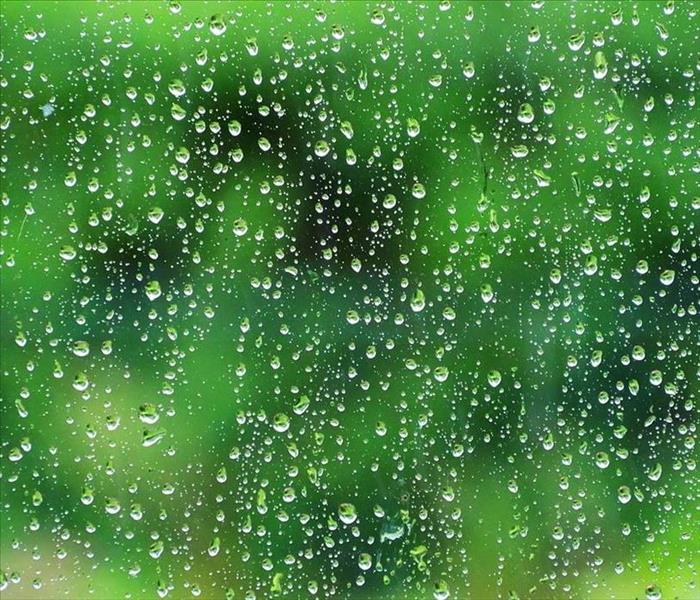 Floods are prone to happen after heavy rainstorms in the San Fernando Valley.
Floods are prone to happen after heavy rainstorms in the San Fernando Valley.
Flooding Services for Your Home or Business
SERVPRO of Central Glendale is available 24 hours a day for flooding and water emergencies, large and small. When you are dealing with water damage, immediate action is crucial. A delay of even a few hours may increase the severity of the water damage. The more that time passes, the worse it can get.
We Answer the Phone Ready to Help
We understand that when you pick up the phone and call us, you may feel confused, stressed, and vulnerable. A flooding incident in your home or business can turn your world upside down. You need an expert to guide you through this crisis. SERVPRO of Central Glendale has the specific water damage training and experience to help you through this tough time. We specialize in water damage restoration—in fact, it's the cornerstone of our business. If you are experiencing a flood emergency, please give us a call at 818-246-2200.
What to Expect from Our Restoration Team
We will ask several questions regarding your water damage emergency when you call. These questions will help us determine what equipment and resources to bring, including how many trained SERVPRO Professionals may be needed.
Our SERVPRO Representative will ask several questions:
- Your name and contact information
- Your insurance information (if applicable)
- The street address of the water-damaged home or business
- When did the flooding or water damage occur?
- What caused the water damage (if known)?
- Is there electricity available (on-site)?
About SERVPRO of Central Glendale
SERVPRO of Central Glendale specializes in the cleanup and restoration of residential and commercial property after a fire, smoke, or water damage event. Our staff is highly trained in property damage restoration. From initial and ongoing training at SERVPRO’s corporate training facility to regular IICRC-industry certification, rest assured our staff is equipped with the knowledge to restore your property.
Storm Damage Will Invade Your Residence Anytime
10/1/2022 (Permalink)
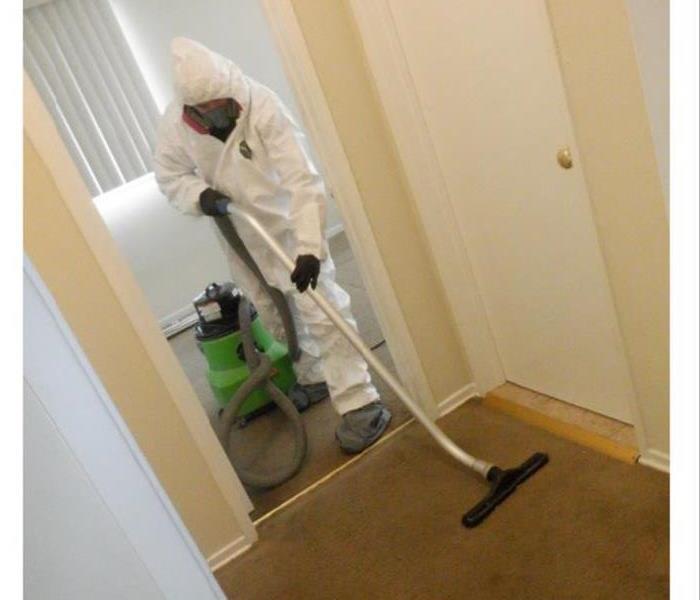 Our Storm technicians are experts in extracting all water from rain right out of your home.
Our Storm technicians are experts in extracting all water from rain right out of your home.
Flooding in a Residential Home
If you happen to be experiencing water damage from the recent storm that hit Southern California, you are not alone. Many Glendale residents as well as those in the surrounding areas experienced water damage and flooding in their homes and businesses. Once the storm passed, not everything was sunshine and rainbow.
This residence in Glendale, California had the same unpleasant situation with rainwater flooding into their home from the backyard. The sliding patio door was not enough to keep the stormy weather out. Because of this, all the carpeting in the family room was completely soaked. When our technicians got to the residence, they checked the saturation level and the water had made it to the padding, located under the carpeting. The first call to action was to extract all the excess water from the residence. It was finding its way down the hallway, which our water damage technicians discovered could be saved and dried.
SERVPRO® of Central Glendale’s Storm Technicians Got to Work
Once the carpeting in the family room was damp enough to handle, our technicians began to remove it, so it would not begin the mold growth process. Our experts understood that if the carpet was left, it would have been subject to mold growing under it in no time. That could lead to bigger issues in the coming weeks, with foul smells and possible health scares.
Once the residential property owner signed paperwork and our storm damage techs got to work removing the rainwater, the home was like new again. The family living in the house got to choose new carpet for the family room plus they did not. have to worry about replacing anything in the hallway area.
Call on the Water Damage Experts
If you live in a residence that has experienced recent storm damage, we would like to help. Call us at 818-246-2200 today and speak to our certified staff. Every situation is different, and we will accommodate to your unique circumstances.
How to Dry Carpets After a Storm Flood
9/23/2022 (Permalink)
 It is best to remove carpet and padding as soon as possible if it can't be saved. Your pros at SERVPRO can take care of this for you.
It is best to remove carpet and padding as soon as possible if it can't be saved. Your pros at SERVPRO can take care of this for you.
Rainfall Can Affect Carpets and Rugs
If the recent rainy weather from Tropical Storm Kay has flooded your home, it can quickly lead to various forms of water damage. Porous materials like rugs and carpets tend to be more severely affected by water. This means it is crucial to restore any wet carpeting as soon as possible. It is best to take immediate action, or it can lead to mold growth as well as other types of damage. Keep these guidelines in mind to properly clean your carpet and help it recover from water damage after after a storm.
Dry the Area
To prevent any further damage from happening, be sure to thoroughly dry all wet areas of your home immediately. Be sure to call water damage companies that are certified. Our office for example will point fans towards your carpets as well as the surrounding space to ensure that all moisture evaporates completely. Drying your home during the restoration process can help accomplish the following:
- Circulating fresh air
- Removing excess moisture
- Preventing mold growth
In addition, removing any leftover water from your carpeting can keep water damage under control until help arrives.
Inspect Your Home
Water damage has a way of hiding in the most unexpected areas of your home. To properly assess the level of damage after a storm has passed, be sure to inspect your living space from top to bottom. This includes checking your carpet padding as well as the carpets themselves to identify any traces of moisture.
Call a Professional
After flooding has happened in your home, it is crucial to take the proper measures to keep any additional harm away. Once you have done this, be sure to call an experienced professional who can handle the watery problem. An expert like SERVPRO® of Central Glendale can identify any signs of water damage that you may not have notice on your own and help restore your home back to the way it was.
Flooding after a thunderstorm is a major source of stress for many homeowners. However, with the help of water damage restoration professionals, your home can return to its normal state in no time. Please give our water damage experts a call at 818-246-2200 to see how our office can help you today.
What To Do When a Storm Hits
8/4/2022 (Permalink)
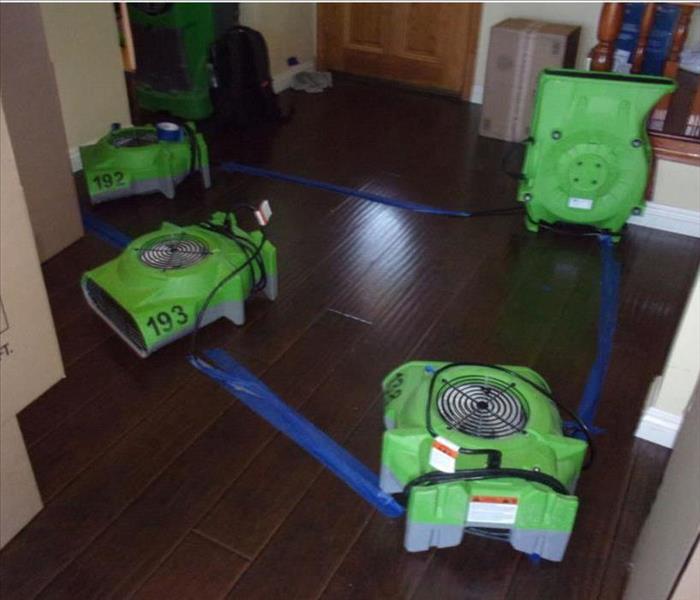 SERVPRO of Central Glendale's fast drying equipment will have your home dry in no time after a storm.
SERVPRO of Central Glendale's fast drying equipment will have your home dry in no time after a storm.
Before a storm hits
Before rain ever hits, you need to make sure you have knowledge of the following:
- Secure outdoor objects that could blow away or cause damage
- Remember the 30/30 Lightning Safety Rule: Look for lightning and go indoors if you cannot count to 30 before hearing thunder; stay indoors for 30 minutes after hearing the last thunder strike in the area
- Consider investing in a personal lightning detector
- Unplug electronic equipment
- Remove dead or rotting trees and branches that could fall
- Shut all windows and secure outside doors
Waiting it out
As bad as this sounds, it is the best thing you can do for the safety of yourself and others. Be sure to:
- Avoid contact with electrical equipment or cords, including devices plugged in for recharging (consider unplugging valuable electronics in case of power surge)
- Any contact with plumbing is bad news since water conducts electricity
- Stay away from windows and doors and stay off porches
- If you are driving, safely exit or pull over and park; do not touch any surface that conducts electricity in or outside of the vehicle
- Do not lie on concrete floors or lean against concrete walls
- Avoid natural lightning rods, such as tall, isolated trees, and avoid isolated small structures in open areas
- Avoid contact with metal, including farm equipment, motorcycles, golf carts and bicycles
After the storm damage is done
Once the storm has gone, now is the time to do the following:
- Never drive through a flooded roadway
- Stay away from power lines that are down and report them immediately
- Avoid storm-damaged areas
- Help people who may require special assistance
- Watch your pets closely; keep them indoors if possible
- Give SERVPRO of Central Glendale a call now!
If the recent flash flood warnings have you stressed out, do not worry. Give the best professional water damage technicians in your area a call at 818-246-2200 today.
Storm Damage in Glendale
7/28/2022 (Permalink)
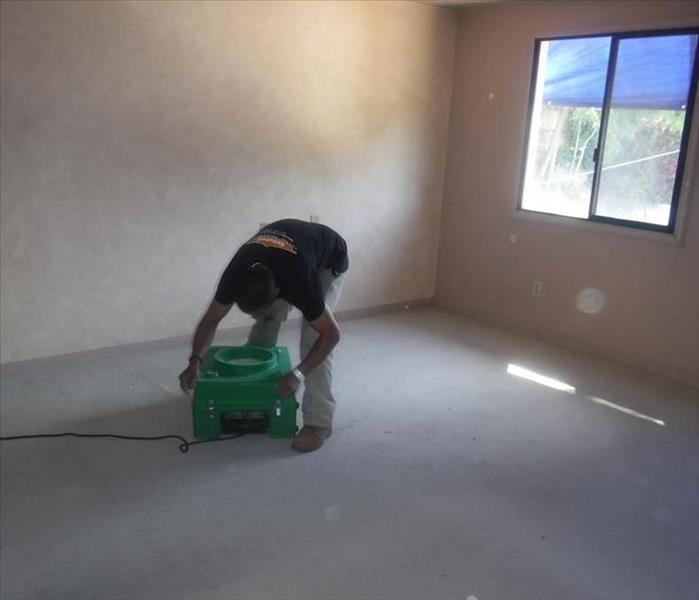 The water damage technicians at SERVPRO of Central Glendale are highly trained for every situation.
The water damage technicians at SERVPRO of Central Glendale are highly trained for every situation.
If there is one thing about California, the weather can be unpredictable. One moment, we are trying to survive a heatwave and then we are dealing with a flash flood the next. When a random storm strikes, disaster can wreak havoc on your property.
Flash flood emergency in Glendale
There are precautions you can take to prepare for a storm, but what if the damage is already done? This is what happened to a local Glendale resident when a random storm came rolling in. The couple was at work when the storm damage happened to their home. The rains were so heavy, it completed flooded their backyard and seeped into the kitchen. There was so much water that flooded their home, it even made it to the living room and the guest bedroom.
As soon as the couple got home, they were over their heads. With rainwater all over the first story of their home, they had no idea what to do. They acted fast and called SERVPRO of Central Glendale right away. Since it was so close, our water damage technicians were there within twenty minutes of them calling. After the homeowners signed paperwork and contacted their insurance company, our team got to work.
Water damage technicians to the rescue
First, our team inspected the damage and took information down regarding the water damaged area. They took photos and drew out a sketch of the floorplans that helps the team locate all the affected areas. After that, the water damage technicians began extracting all the access water in the home. After the water was completely extracted out, the floors and carpet were still very damp, and it began to smell like mildew.
From there, they began to place air movers and air scrubbers to help clean the air and dry the floors. Each day for a week, our technicians visited the property to check the dryness and humidity percentage. It took about 6 days for everything to be completely dry.
Our water damage technicians are standing by
If you are experiencing water storm damage, please do not hesitate to give us a call at 818-246-2200 anytime - 24 hours a day, seven day a week.
A Roof Caved In at the Dentist Office
1/28/2022 (Permalink)
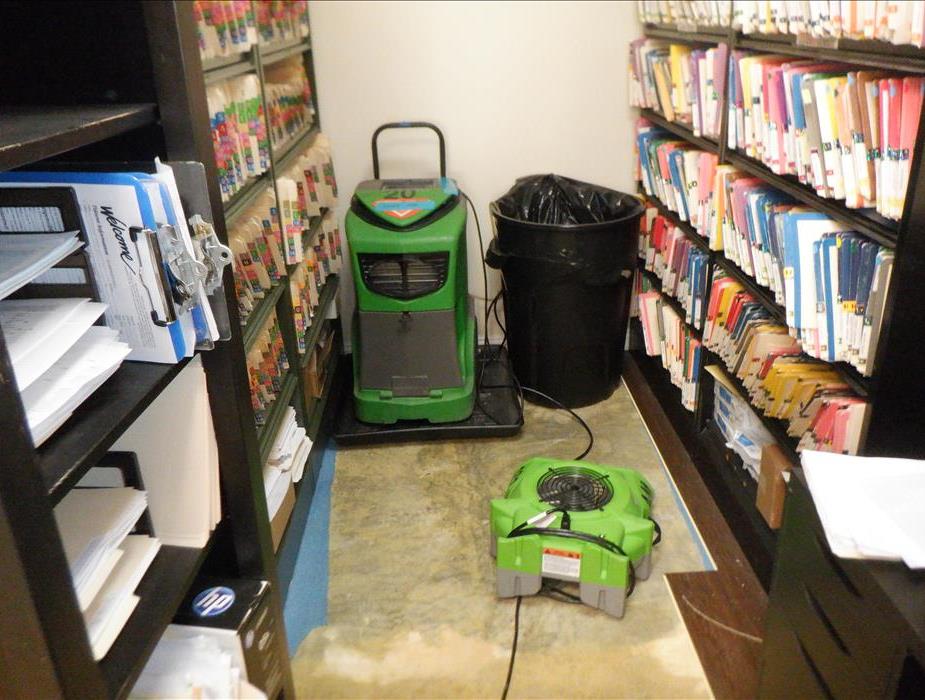 Fans drying out excess water that flooded this local dentist's office.
Fans drying out excess water that flooded this local dentist's office.
When the rain was bad in Glendale, many buildings had flooded and suffered water damage.
A local dentist's office was affected by the recent rains too. The morning staff opened the office doors Monday morning after a rainstorm and to their surprise, stepped into a puddle of water. After the building owner of the dentist's office was notified, they gave SERVPRO of Central Glendale a call right away.
Within the hour, the crew arrived on site and began extracting all the access water that had flooded the office. After inspecting each room in the 1,200 square foot dental office, our SERVPRO’s team leader sketched out the area and marked where the ceiling had fallen. After cleaning up the debris and extracting the water from each of the rooms, the crew then set up equipment to immediately dry the floors, baseboards, and some drywall.
Over the next few days, a certified water damage specialist visited the office and took measurements of the drying process. Measuring the amount of moisture, the room’s temperature, and the humidity of the room allows us to see how fast it is drying. Unfortunately, since the leak happened over the weekend, a small area in the records room had already begun to grow mold underneath the wooden floor. Due to this, a small section, about 4’ x 2‘, had to be removed.
Once it was cleared by the building manager, our crew got to work immediately. They began to demo the small section of the wooden floor and removed the mold by securing the area while wearing PPE suits (safety first). They also built a containment around it from top to bottom to prevent any airborne spores from escaping. After five days, the wall and baseboards were dried completely and any signs of mold were removed.
Certified by the IICRC and always practicing OSHA’s procedures, the technicians here at SERVPRO of Central Glendale are the ones you want when a water damage emergency hits. Give us a call at 818-246-2200 if you find water damage in your home or office.
A Leaky Roof at the Glendale Galleria
1/26/2022 (Permalink)
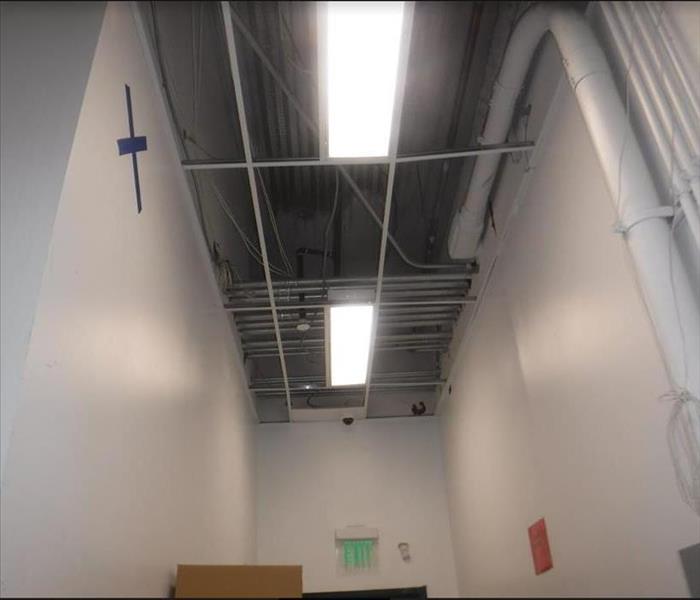 SERVPRO of Central Glendale's certified water damage techs marked a blue "X" where water damage was found.
SERVPRO of Central Glendale's certified water damage techs marked a blue "X" where water damage was found.
When a storm hits Los Angeles, so does SERVPRO of Central Glendale.
Last week, our crew helped the nice property managers that manage the Glendale Galleria. The heavy rain wreaked havoc on the roof, forcing storm water to leak into the building.
The water damage technicians of Glendale’s very own SERVPRO were onsite in minutes. Greeted by a property management representative and mall manager, our lead technician evaluated the damage, took lots of photos. He also took measurements of the damaged ceiling and sketched a small blueprint of the surrounding area, which was one of the hallway entrances for mall employees. The lead tech eased the managers by assuring them it was a roof leak that could have turned disastrous if it wasn’t taken care of.
After the paperwork was signed, our certified water damage technicians got to work extracting the storm water that had fallen through and flooded the walkway with an inch of water. Two of our most experienced techs climbed up 20 feet to the roof and tarped the hole. Since there was a break in the rain, our techs were able to go up and tarp it safely. Once the hole in the roof was securely covered, the lead technician checked the ceiling and surrounding drywall with a moisture meter to confirm there was no moisture from the rain that may have seeped through it. Unfortunately, there was a small section of drywall towards the ceiling that was wet, which had to be removed to prevent an even bigger mold problem.
Although there was some minor storm damage done to the drywall, the crew saved as much as they could. At the end of the day, SERVPRO of Central Glendale’s own water techs saved the Glendale Galleria thousands of dollars by handling the storm situation as soon as possible and avoiding mold. If the southern California rains have given your property water damage or you suspect a mold problem, give our office a call at 818-246-2200 to see how we can help today.
Roof leak problems!
8/20/2020 (Permalink)
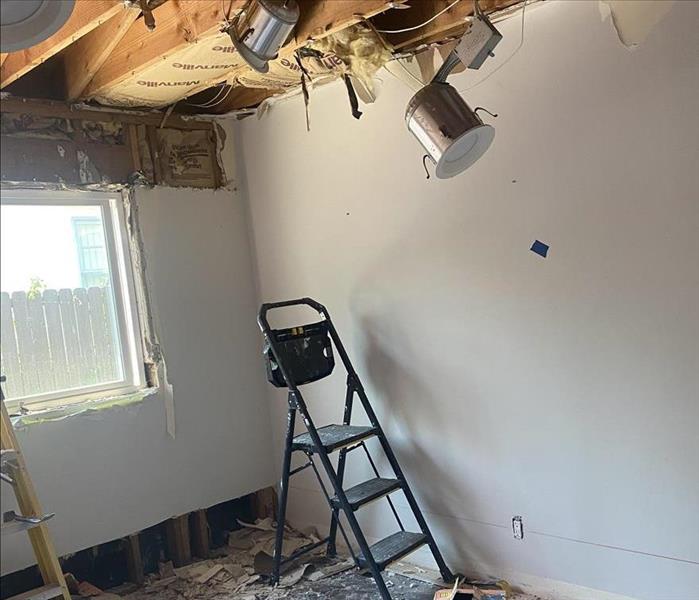 Demolished ceiling cause by water damage.
Demolished ceiling cause by water damage.
It is no secret that when a roof leaks, the water will travel to the attic and eventually make its way to the inside of the property affecting cabinets, flooring and important contents.
You may be wondering, what’s next? We got you covered!
Here is a helpful protocol to follow when you go through water damage.
You must begin by minimizing the damage as soon as possible. In order or to do that you must stop the water damage by discovering where the water damage is coming from.
Once you find where the water is coming from you must contain it as much as possible in order to prevent further damage. You must contact your insurance agent to file a claim. Do you have water damage? Call us at (818) 246-2200 we will be more than happy to guide you through the process.
Unexpected Rain In Glendale
8/11/2020 (Permalink)
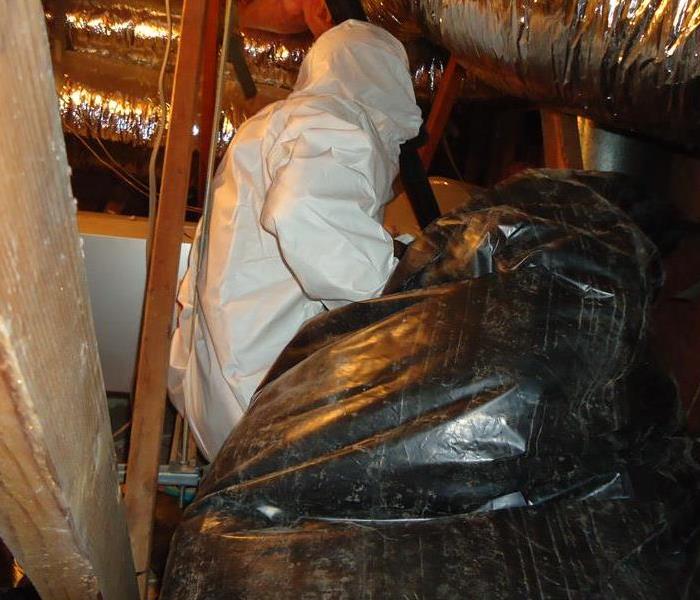 Insulation installation!
Insulation installation!
SERVPRO of Central Glendale is known to be fast to respond to any disaster and with the unexpected rain in Los Angeles, we are ready and prepared for anything. This Glendale home suffered from unexpected rain but we were there to make them feel at ease. Unfortunately, their home was damaged due to the rain causing their roof to leak and damage their attic, effecting their insulation. Something very important to know as a homeowner is that when the insulation in your home gets soaked, the insulation will retain absorbed water for an extended period of time. During that time, it is likely that it will degrade wooden structure and cause attic mold growth. Lucky for them, we also specialize in mold remediation and restoration. Do you think you may have mold growth? Give us a call at (818) 246-2200, we are happy to help!
When Rainwater Damage Attacked a Glendale Property
1/6/2020 (Permalink)
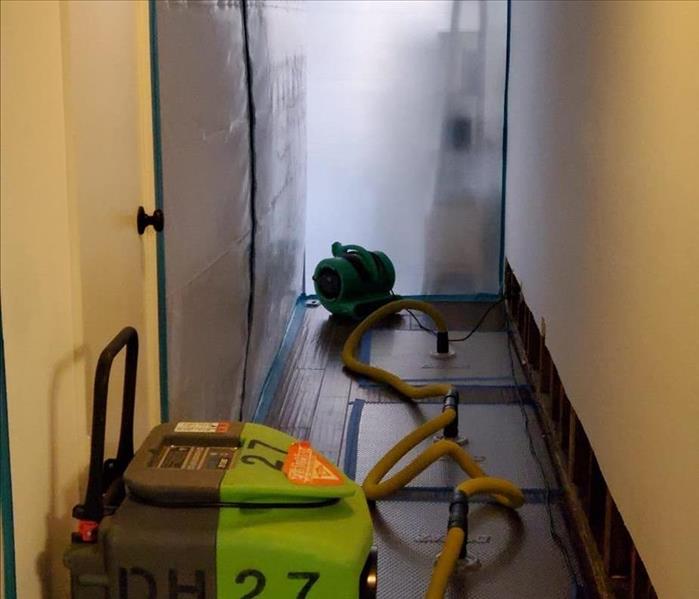 SERVPRO of Central Glendale to the rescue! Extracting water with the best equipment.
SERVPRO of Central Glendale to the rescue! Extracting water with the best equipment.
Discovering a flood in the restroom and rooms of this finance office in Central Glendale was not making the property manager happy. After the not so common rain came to Los Angeles, it did some major damage to the carpet, drywall and baseboards. When we did our walk through with the property manager of the commercial building, our production manager suggested what should be done. After all of his questions had been answered, he was confident that we would have his building in tip top shape and the finance office back in business.
Our SERVPRO technicians began to measure every inch of the drywall to see exactly how much moisture was soaked up. After doing a sketch of the entire office and marking where the water damage was, we began to extract excess water from the carpet and dried it in place. As for the drywall, we had to do some demolition and cut about 1 foot up from the floor. This was not too bad, since we saved the rest of the wall in the office. We had a very trusted vendor do the reconstruction, while our team was closely involved.
The property manager was happy to see that we performed and completed everything that had to be done in under two weeks. If you would like to schedule an inspection for storm damage that has happened to your commercial property, call us at 818-246-2200 and we will explain the next step to you.
Saving a Glendale Office from a Soggy Carpet
1/6/2020 (Permalink)
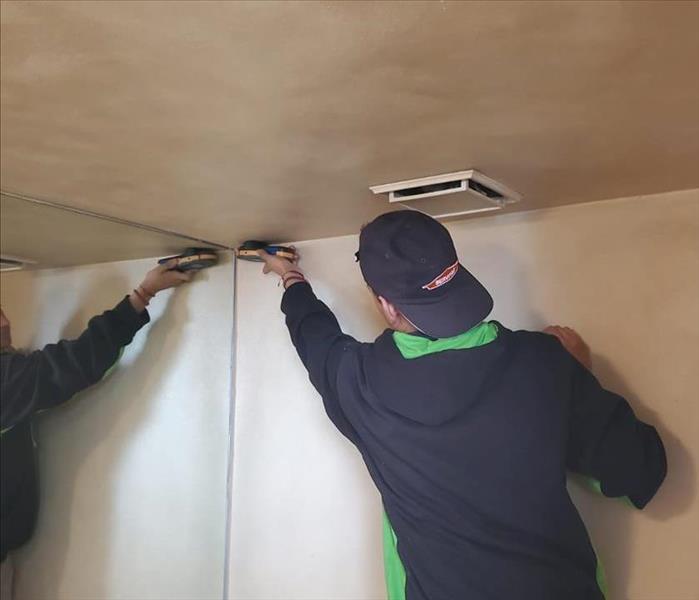 Our team is on standby and is ready to help whenever you need us.
Our team is on standby and is ready to help whenever you need us.
Rain can be unpredictable enough, but when storm damage is involved it can make matters even more complicated. In fact, this office located in Glendale, California for example experienced just that. Through the holiday season, they were closed for business and did not discover the damage from the rain until the office manager returned two days later.
When she and the rest of the staff saw that every inch of the carpet was soaked and files in cardboard boxes have been saturated, they began to panic. When we arrived on the scene, we let them know everything was going to be okay. Our production team began to extract water immediately from the wet carpet while the production manager measured what areas were wet and which were dry in the corners. After thoroughly checking for moisture, extracting all water and drying for a few days, we were able to save the carpet, saving the office and property manager hundreds of dollars.
If you have water damage due to a recent storm, let our office help! Give us a call at (818) 246-2200 to schedule an inspection today. Our team is standing by and would be happy to help.
Storm Flooding at a Glendale Elementary School
12/26/2019 (Permalink)
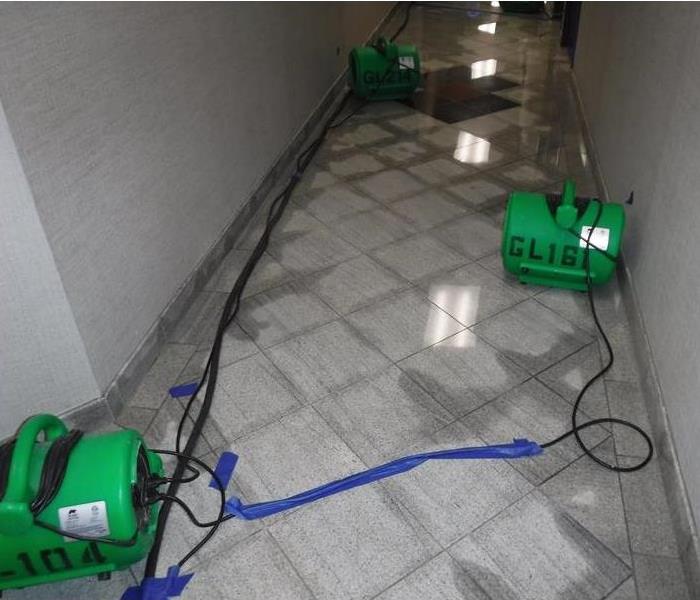 We believe in restoring before replacing.
We believe in restoring before replacing.
When the teachers, staff and students went on Thanksgiving break, no one expected the heavy rains to flood an entire section of their classrooms. The recent storms damaged multiple classrooms, completely saturating the carpets, baseboards and drywall with rainwater. When our technicians arrived at the Glendale elementary school, the staff worried that it would not be reversible. After the water extraction wands began to immediately suck the water up from the carpet, they were overjoyed.
We moved desks, chairs, wet boxes filled with paperwork and even a few instruments out of the rooms (content manipulation) and saved as much as possible for the teachers and students. We did not even have to cut any drywall, since our certified crew strategically drilled holes into it and dried it out. Just one way our experienced professionals dry out water damage.
We believe in restoring versus replacing, saving you thousands of dollars and precious time. If you have recently experienced water damage from the rain, do not hesitate to give SERVPRO of Central Glendale a call at 818-246-2200 and set up an inspection today.
Be Storm Prepared with These Helpful Tips
12/19/2019 (Permalink)
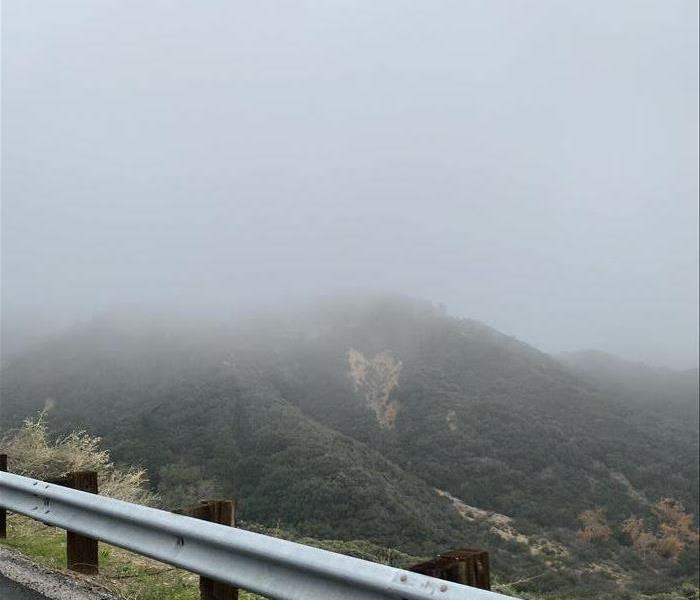 Be prepared for the next storm that hits, our tips can be helpful.
Be prepared for the next storm that hits, our tips can be helpful.
As busy as we are every day, the last thing on anyone’s mind is storm damage. From our experience,
when business and homeowners are storm prepared, they usually avoid watery situations. Imagine
stepping into a puddle of water inside your building in complete darkness! Follow these storm damage
tips and be prepared for the next rainfall that comes.
-Have a battery powered radio handy for the latest news
-Keep a flashlight handy with spare batteries
-Check for any storm warnings and weather advisories
-Be sure there is a good amount of canned and packaged food available
-Always keep a two-week water supply for every person in your household
If the storm has already hit your business or place of residence, reach out to us and give us a call at
(818) 246-2200.
Be Ready For Whatever Comes Your Way!
11/21/2018 (Permalink)
 Be Ready for Any Disaster
Be Ready for Any Disaster
National Preparedness Month is just around the corner and it’s a great time to make sure you and your family is prepared for potential disasters. National Preparedness Month, which takes place in September, strives to increase the overall number of individuals, families, and communities that engage in preparedness actions at home and work.
Join in the effort to get your home ready for potential disasters. Only 51.5% of U.S. homes have an emergency kit ready. By creating an Emergency Kit you can be “Ready for whatever happens.”
Ready.gov suggests you have enough supplies to last for at least three days. Below is a quick list of suggested items to include in your kit:
- 3-day supply of nonperishable foods
- Water (one+ gallon per person per day)
- First-aid kit
- Prescription medication
- Sleeping bag or blankets
- Fire extinguisher
- Hygiene products
- Flashlights
- Extra batteries
- Cell phone charger
- Change of clothes
- Matches in waterproof container
- Wrench or pliers to turn off utilities
- Whistle to signal for help
- Pet supplies
- Infant formula and diapers
- Important documents such as insurance policies, IDs, and bank records in a plastic container
Also, keeping a small emergency kit in your vehicle can be useful during an emergency.
Tips on Staying Safe During Windstorm
11/21/2018 (Permalink)
 There’s not always a lot of warning before a large windstorm hits, so it’s important to prepare your home well beforehand.
There’s not always a lot of warning before a large windstorm hits, so it’s important to prepare your home well beforehand.
Windstorms cause millions of dollars of damage across the Pacific Northwest every year. There’s not always a lot of warning before a large windstorm hits, so it’s important to prepare your home well beforehand. Small fixes now can prevent more costly repairs after a storm.
Trim Your Trees
Check your property for any tree branches that hang over your roof, cars, power lines, or shed. Overhanging branches can cause significant damage to your property if they fall, which you can easily prevent by cutting them down before a storm hits.
If you have dead trees or branches on your property, get them professionally removed.
Inspect the Roof and Garage
Any loose roofing material will be particularly susceptible during a windstorm. Further damage can occur when a windstorm rips loose material off the roof. Before the windstorm hits, check your roof for loose shingles, flashing, gutters, edging strips, etc. Make sure any problems you find are fixed ASAP.
Your garage door, if it is not in top shape, can be a liability as well. If you haven’t had it professionally inspected in a while, consider doing so.
Protect Your Windows
Strong winds and flying debris can damage windows, so make sure they are prepared before the storm comes in. If you don’t have stormproof windows installed, you can use aluminum or steel shutters or plywood to protect your windows from damage.
Secure Items Around Your Property
While wind can cause a lot of damage on its own, loose items around the yard can severely increase the damage potential. If you received a report of an impending windstorm, secure or safely store items like:
- Grills
- Patio Furniture
- ATVs
- Garbage and recycling bins
- Container plants
- Wind chimes and other decor
- Trampolines
- Swing sets and toys
- Bicycles
Make sure to store cleaning chemicals, motor fuels, and pesticides in safe places as well. You don’t want chemicals to mix together or spread throughout your yard or home
Put Together an Emergency Kit
If the windstorm takes out the power, in some cases you may have to go without electricity for a few days until it gets fixed. Prepare emergency kits with food, water, and anything else your family might need to get through three days without power.
Even the most prepared home can sustain damage during a bad windstorm. Fortunately, at SERVPRO® of Central Glendale, we’re prepared to restore your home “Like it never even happened.”
We offer a wide range of services (like board-ups, water damage restoration, tree removal, tarp-ups, and other roofing services) to help repair your property after a storm.
Rain in the forecast for California fire areas brings concern over possible debris flow
11/20/2018 (Permalink)
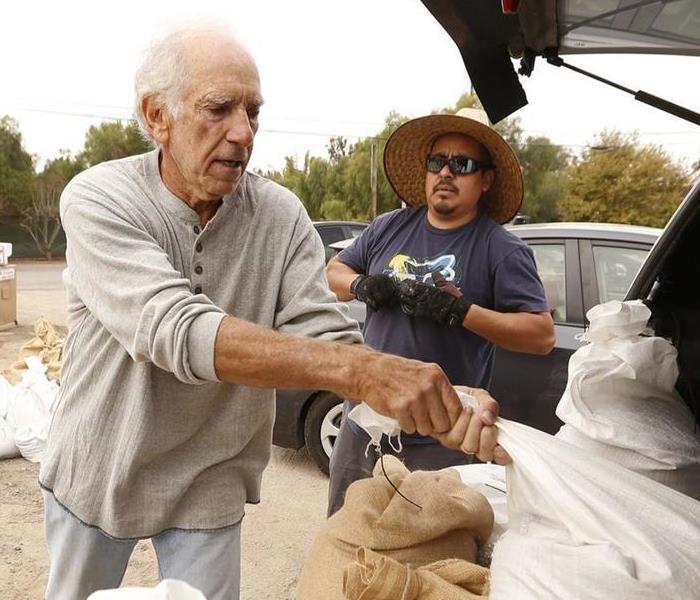 Victor Lobl, loads sandbags provided by the LA County Fire Department on Monday with the help of friends to protect what's left of his home
Victor Lobl, loads sandbags provided by the LA County Fire Department on Monday with the help of friends to protect what's left of his home
or residents whose homes were spared by massive wildfires burning throughout the state this month, rains expected this week are prompting concern about another potentially destructive and deadly phenomenon: mudslides.
Weather experts said that rain is likely to fall midweek over areas recently affected by the Camp and Woolsey fires. The area hit by the Woolsey Fire, which spread west of the San Fernando Valley and burned to the coast, is expected to see between half an inch to an inch of rain late Wednesday into early Thursday. Showers could linger into Thursday morning, said David Sweet, a meteorologist with the National Weather Service in Oxnard.
The Woolsey blaze ravaged nearly 97,000 acres and destroyed 1,500 structures in Los Angeles and Ventura counties. Three people died and three firefighters were injured.
Heavier precipitation is anticipated in Northern California, in the area of the Camp fire. A series of storms beginning early Wednesday and lasting through Saturday is expected to bring 3 to 5 inches of rain. That fire charred 151,000 acres and destroyed more than 12,000 homes. The death toll of 79 is expected to rise as workers comb through the ruins.
During a Landslide
11/20/2018 (Permalink)
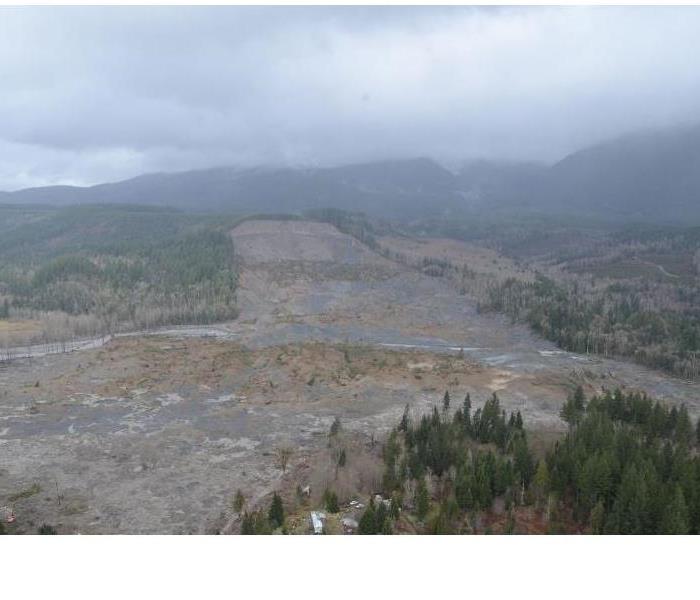 Aftermath of a Mudslide
Aftermath of a Mudslide
What should I do if a landslide is occurring or likely to occur?
- If you suspect imminent danger, evacuate immediately. Inform affected neighbors if you can, and contact your public works, fire or police department.
- Listen for unusual sounds that might indicate moving debris, such as trees cracking or boulders knocking together.
- If you are near a stream or channel, be alert for any sudden increase or decrease in water flow and notice whether the water changes from clear to muddy. Such changes may mean there is debris flow activity upstream so be prepared to move quickly.
- Be especially alert when driving— watch for collapsed pavement, mud, fallen rocks and other indications of possible debris flow.
- If you are ordered or decide to evacuate, take your animals with you.
- Consider a precautionary evacuation of large or numerous animals as soon as you are aware of impending danger.
During Severe Storms
- Stay alert and awake. Many deaths from landslides occur while people are sleeping.
- Listen to local news stations on a battery-powered radio for warnings of heavy rainfall.
- Consider leaving if it is safe to do so.
Heavy Rain
1/15/2018 (Permalink)
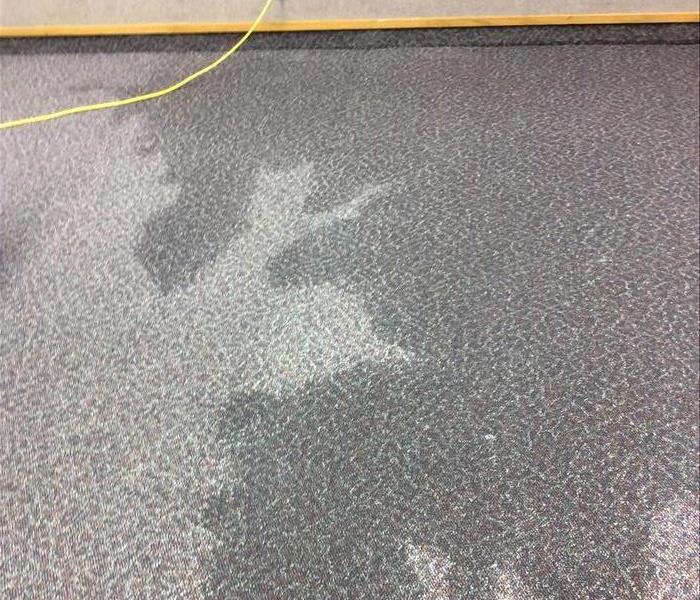 Roof leak
Roof leak
A roof leak caused this room to have damages to the walls and floors of a church located in the Los Angeles area. This picture shows the mess left behind after all the water had receded. SERVPRO of Central Glendale was called in to do an inspection and withinn an hour we came back with our equipment, and than we started to do our work. SERVPRO of Central Glendale finished the job within five days. The owner of the buliding was thrilled when we arrive prepared and ready to work. He said, "I was very impressed with the work that they did, they were very polite and organized. Now I know who to call just in case if I ever have any damages at all."
When storms hit LA, SERVPRO is ready!
1/12/2018 (Permalink)
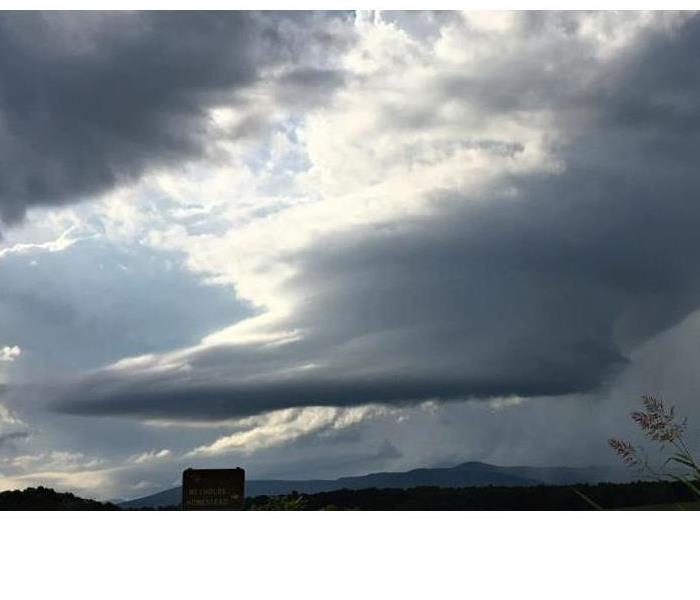 Storms hit LA area, SERVPRO will be ready to take action!
Storms hit LA area, SERVPRO will be ready to take action!
SERVPRO of Central Glendale specializes in storm and flood damage restoration. Our crews are highly trained and we use specialized equipment to restore your property to its pre-storm condition.
Faster Response
Since we are locally owned and operated, we are able to respond quicker with the right resources, which is extremely important. A fast response lessens the damage, limits further damage, and reduces the restoration cost.
Resources to Handle Floods and Storms
When storms hit Glendale, we can scale our resources to handle a large storm or flooding disaster. We can access equipment and personnel from a network of 1,650 Franchises across the country and elite Disaster Recovery Teams that are strategically located throughout the United States.
Have Storm or Flood Damage? Call Us Today (818) 246-2200
What to do during a storm?
10/13/2017 (Permalink)
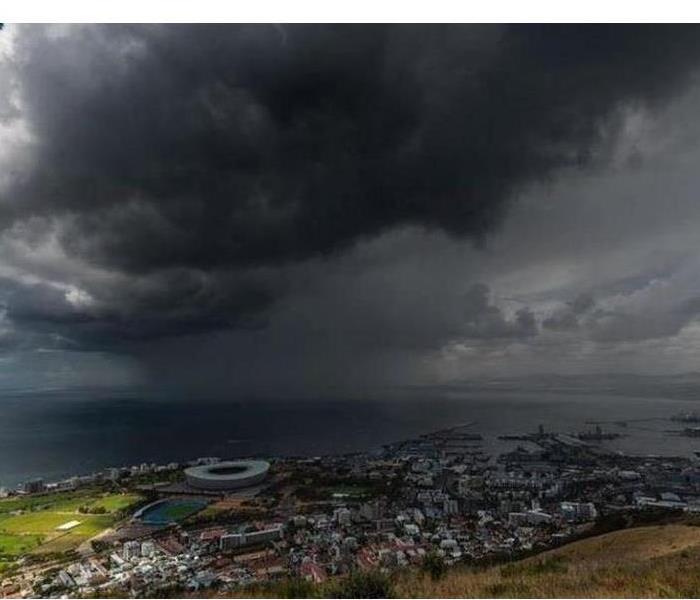 Most of the U.S. will experience thunderstorms from time to time, but the state with the highest occurrence of storms might be surprising.
Most of the U.S. will experience thunderstorms from time to time, but the state with the highest occurrence of storms might be surprising.
Before
- Remember the 30/30 Lightning Safety Rule: Look for lightning and go indoors if you cannot count to 30 before hearing thunder; stay indoors for 30 minutes after hearing the last thunder-clap
- Consider investing in a personal lightning detector
- Remove dead or rotting trees and branches that could fall
- Secure outdoor objects that could blow away or cause damage
- Shut all windows and secure outside doors
- Unplug electronic equipment
During
- Avoid contact with electrical equipment or cords, including devices plugged in for recharging (consider unplugging valuable electronics in case of power surge)
- Water conducts electricity, so avoid contact with plumbing
- Stay away from windows and doors and stay off porches
- Do not lie on concrete floors or lean against concrete walls
- Avoid natural lightning rods, such as tall isolated trees, and avoid isolated small structures in open areas
- Avoid contact with metal, including farm equipment, motorcycles, golf carts and bicycles
- If you are driving, safely exit or pull over and park; do not touch any surface that conducts electricity in or outside of the vehicle
After
- Never drive through a flooded roadway
- Avoid storm-damaged areas
- Help people who may require special assistance
- Stay away from downed power lines and report them immediately
- Watch your pets closely; keep them indoors if possible
Tornado Safety
10/13/2017 (Permalink)
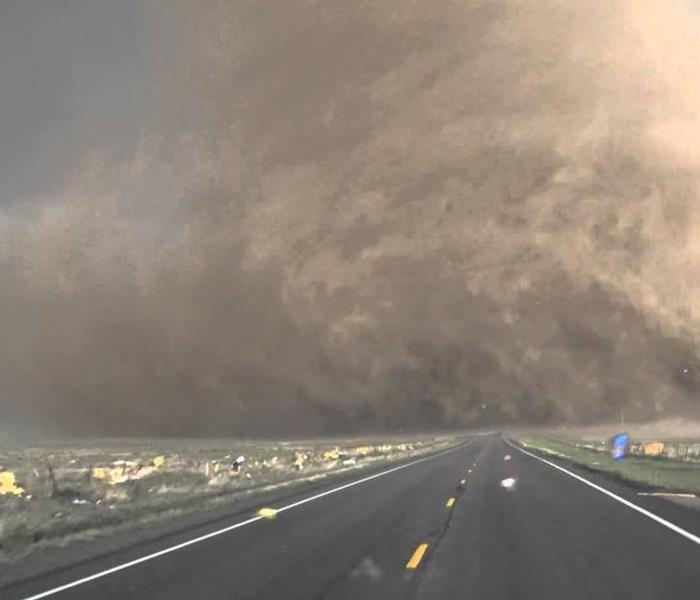 A tornado is a violently rotating column of air that extends from a thunderstorm.
A tornado is a violently rotating column of air that extends from a thunderstorm.
When a severe thunderstorm is imminent or already occurring in your area, it's time to put your plan into action. Pay close attention to any storm watches or warnings that have been issued for your location.
If You're in a Building
- Make sure you have a portable radio, preferably a NOAA Weather Radio, for weather alerts and updates.
- Seek shelter in the lowest level of your home, such as a basement or storm cellar. If you don't have a basement, go to an inner hallway, a smaller inner room or a closet.
- Keep away from all windows and glass doorways.
- If you're in a building such as a church, hospital, school or office building, go to the innermost part of the building on the lowest floor. Do not use elevators because the power may fail, leaving you trapped.
- You can cushion yourself with a mattress, but don't cover yourself with one. Cover your head and eyes with a blanket or jacket to protect against flying debris and broken glass. Don't waste time moving mattresses around.
- Keep pets on a leash or in a crate or carrier.
- Stay inside until you're certain the storm has passed, as multiple tornadoes can emerge from the same storm.
- Do not leave a building to attempt to "escape" a tornado.
If You're Outside
- Try to get inside a building as quickly as possible and find a small, protected space away from windows.
- Avoid buildings with long-span roof areas such as a school gymnasium, arena or shopping mall, as these structures are usually supported only by outside walls. When hit by a tornado, buildings like these can collapse, because they cannot withstand the pressure of the storm.
- If you cannot find a place to go inside, crouch for protection next to a strong structure or lie flat in a ditch or other low-lying area. Cover your head and neck with your arms or a jacket, if you have one.
If You're in a Car
- If you can safely drive away from the tornado, do so.
- If there is a sturdy structure available, go inside.
- If no building is available, it might be better to pull over, stop the car (but leave it running so the air bags work), and crouch down below the windows. The airbags and frame of the car will offer some amount of protection, but certainly not absolute safety.
- A long-standing safety rule has been to get out of the car and into a ditch. If you do that, you should get far enough away from the car that it doesn’t tumble onto you. Being below the prevailing ground level may shield you from some of the tornado wind and flying debris, but there is still danger from those.
- Do NOT get out of a vehicle and climb up under the embankment of a bridge or overpass. This often increases your risk.
If You're in a Mobile Home
- Do not remain in a mobile home during a tornado. Even mobile homes equipped with tie-down systems cannot withstand the force of a tornado's winds.
- Heed all local watches and warnings, and leave your mobile home to seek shelter as quickly as possible before a tornado strikes, preferably in a nearby building with a basement.
- If no shelter is immediately available, find the lowest-lying area near you and lie down in it, covering your head with your hands.
Rules for Storm Safety
8/24/2017 (Permalink)
1. Have a storm safety kit handy. You can make your own kit at home.
2. Stay inside during thunderstorms and blizzards. Lightning, wind and ice can damage power lines, making them very dangerous. It's also important to stay off the phone and computer during a storm too.
3. Use flashlights instead of candles. Using candles during a storm is a big fire hazard.
4. Don’t open the refrigerator or freezer unless you absolutely need to. Keeping the door closed as much as possible will make the food last longer.
5. If your power goes out, notify the power company right away. The more calls or notifications they get, the faster they can find and fix the problem.
6. Don’t try to use a gas appliance to keep warm. Using a gas appliance the wrong way can cause deadly carbon monoxide. Bundle up in layers of clothes instead.
7. Ask someone to unplug as many appliances as possible. This will help prevent damage when the power comes back on.
8. Don’t stand near portable generators or heaters. This equipment is very dangerous, so stay far away.
9. Stay away from damaged or downed power lines. Even utility workers can't tell if a power line is energized just by looking at it.
10. Watch out for power lines when they're cleaning up outside. If power lines are running through damaged trees, call the electric company for help.
Thunder and Safety Thunders
8/24/2017 (Permalink)
Learn how to protect you and your loved ones during a thunderstorm.
The weather forecast calls for a slight chance of thunderstorms, but you can only see a few fluffy white clouds overhead. So you and your tennis partner grab your racquets and balls and head for the tennis court. You spend a few minutes warming up and then—wait! Is that thunder you hear? Was that a lightning flash?
What do you do? Keep playing until the thunder and lightning get closer? Go sit on the metal bench under the trees to see what happens? Or get in your car and drive home?
Correct answer: If no substantial, non-concrete shelter is nearby, get in your car and wait out the storm.
Why? Because being outside when lightning is present is not something to take lightly—ever.
Risks of Lightning Strikes
Although the odds of being struck by lightning in a given year are only around 1 in 500,000, some factors can put you at greater risk. Lightning most often strikes people who work outside or engage in outdoor recreational activities. Regional and seasonal differences can also affect your risk of being injured by lightning.
In 2016, Florida, Louisiana, New York, Mississippi, Colorado, North Carolina, and Texas had the most lightening deaths.
The consequences of lightning strikes are serious. Lightning is one of the leading causes of weather-related fatalities. During 2004–2013, lightning caused an average of 33 deaths per year in the United States.
When you see lightning, take safety precautions.
Protect Yourself from Lightning Strikes
You can protect yourself from risk even if you are caught outdoors when lightning is close by.
Safety precautions outdoors
- If the weather forecast calls for thunderstorms, postpone your trip or activity.
- Remember: When thunder roars, go indoors. Find a safe, enclosed shelter.
- The main lightning safety guide is the 30-30 rule. After you see lightning, start counting to 30. If you hear thunder before you reach 30, go indoors. Suspend activities for at least 30 minutes after the last clap of thunder.
- If no shelter is available, crouch low, with as little of your body touching the ground as possible. Lightning causes electric currents along the top of the ground that can be deadly over 100 feet away.
- Stay away from concrete floors or walls. Lightning can travel through any metal wires or bars in concrete walls or flooring.
Although you should move into a non-concrete structure if possible, being indoors does not automatically protect you from lightning. In fact, about one-third of lightning-strike injuries occur indoors.
Safety precautions indoors
- Avoid water during a thunderstorm. Lightning can travel through plumbing.
- Avoid electronic equipment of all types. Lightning can travel through electrical systems and radio and television reception systems.
- Avoid corded phones. However, cordless or cellular phones are safe to use during a storm.
- Avoid concrete floors and walls.
Lightning strikes may be rare, but they still happen and the risk of serious injury or death is severe. So take thunderstorms seriously.
Learn and follow these safety rules to keep yourself safe from lightning.






 24/7 Emergency Service
24/7 Emergency Service












